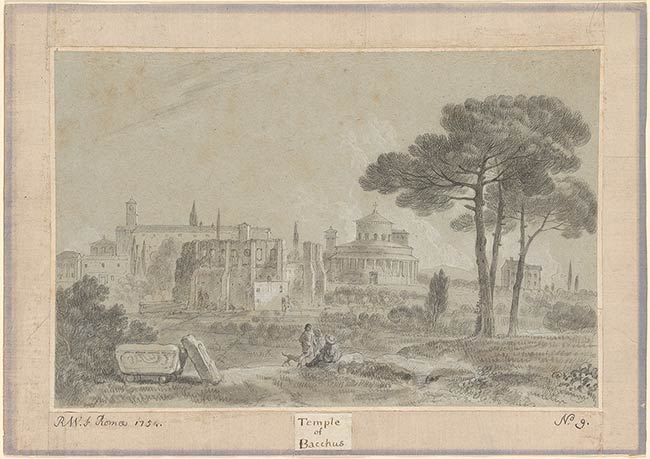
Richard Wilson is considered the founder of the British landscape school. This drawing joins four other landscapes, all from the Fairfax Murray Collection, and one portrait, of the dealer Thomas Jenkins, who is believed to have acted as Wilson's agent in garnering the commission for the present drawing. Wilson began his career as a portraitist. He was encouraged to paint landscapes by Francesco Zuccarelli while on a sojourn in Venice in 1750. He soon had several important commissions from British nobility who admired his talent in combining plein air naturalism with elements of the Arcadian ideal landscape perfected by Claude Lorrain in the previous century. One of those commissions was from the 2nd Earl of Dartmouth, who in 1754 engaged Wilson to produce a suite of sixty-eight autonomous landscape drawings in Wilson's signature medium of black chalk on gray or blue paper. The present drawing is number 49 of the group, and that number appears on the verso of the original backing paper. The suite of drawings passed down through successive earls of Dartmouth and then went missing in 1811. Only twenty-five of the original sixty-eight drawings have come to light, mostly Roman views, and they were found in 1948 by Lady Dartmouth in a cupboard at Patshull House, Staffordshire. They are the most celebrated of Wilson's finished drawings. The present sheet was one of the few remaining in private hands. The drawing was executed in Rome in 1754. It is on the original mount with its lilac-wash border, which was colored by the artist or under his direction. The number on the mount at right represents its place in the sequence of twenty Roman views that formed a subset of the original sixty-eight. The inscription Temple of Bacchus on the mount, which provided the title for the drawing, is anomalous because the Temple of Bacchus is in Greece, not Rome. The drawing represents a composed view that is both actual and imagined. The buildings represented are, at center, the ruins of the Constantinian basilica of Sant' Agnese, the fourth-century church of Santa Costanza behind it to the right, and the seventh-century church of Sant' Agnese fuori le mura to the left. The antique sarcophagus in the foreground has been connected to a sketch by Wilson, and he routinely chose subjects from his sketchbooks for inclusion in his finished landscapes. He may have added the sarcophagus as an allusion to classical antiquity, which would have been understood and appreciated by his sophisticated patron. In its overall design we see the influence of Claude Lorrain, whom Wilson studied closely during his years in Rome. And we see Wilson's legacy to the next two generations of British landscape artists, most especially John Robert Cozens and J.M.W. Turner. Some of that legacy can be found in the large tree at right used as a framing device, the foreground repoussoir with the figures gazing at the splendid view, and the view itself bathed in light.
Signed and dated by the artist on the old mount at lower left, "RW. f Romae 1754", and numbered at lower right, "N [superscript]o. 9."; inscribed on small paper label affixed to old mount, "Temple / of / Bacchus"; on verso on original backing paper, "49".
Dartmouth, William Legge, Earl of, 1731-1801, former owner.
Dartmouth, William, Earl of, former owner.
Loyd, C. L. (Christopher Lewis), 1923- former owner.
Ford, Brinsely. "The Dartmouth Collection of Drawings by Richard Wilson," The Burlington Magazine XC, no. 549, December 1948, p. 345.
Ford, Brinsely. The Drawings of Richard Wilson, London, 1951, p. 29, 59, no. 52, pl. 52.
Constable, W.G. Richard Wilson, London, 1953, p. 99 [not repr.].
Baslett, John and Dudley Snelgrove. English Drawings and Watercolors 1550-1850 in the Collection of Mr. and Mrs. Paul Mellon. New York: Pierpont Morgan Library, 1972, under no. 25.
Solkin, David H. "Some New Light on the Drawings of Richard Wilson," Master Drawings 16/4 (winter 1978), p. 404-5, 412 no. 10
Russell, Francis. The Loyd Collection of Paintings, Drawings and Sculptures, [England?], 1991, no. 138, p. 49, pl. 56.
